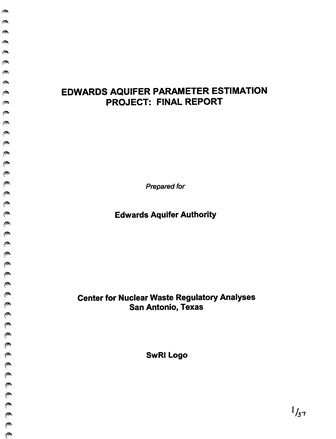Edwards Aquifer Parameter Estimation Project: Final Report

| Author | Painter S (SWRI Center for Nuclear Waste Regulatory Analyses), Jiang Y and Woodbury A (University of Manitoba) |
| Year | 2002 |
| Description | Revision 3 of the hydraulic conductivity model using spatial statistics and various hydrological data calibrated to steady-state hydraulic head measurements and partially calibrated to steady-state spring discharges, for manual calibration of the model and as a basis for fully automated calibrations. This study is included for historical value and may have been supplanted by more recent ones. |
| Publisher | Southwest Research Institute Center for Nuclear Waste Regulatory Analyses |
| Location | Edwards Aquifer, Balcones Fault Zone, San Antonio Segment |
| Cover | View Download |
| File | View Download |
| Summary |
|
This study is included for historical value and may not describe the current model. The purpose of this study was to statistically model hydraulic conductivity measurements and create an input dataset for a computer model of the Edwards Aquifer (MODFLOW model) that is currently under development. The study was completed in May 2002 by Southwest Research Institute, San Antonio, Texas. This work supports ongoing efforts by the Edwards Aquifer Authority to develop a groundwater management model of the San Antonio segment of the Edwards Aquifer. Values of hydraulic conductivity, a key parameter controlling groundwater flow, are assigned to the model grid developed by the U.S. Geological Survey (USGS). The approach used, a combination of spatial statistical methods and advanced techniques for automatic model calibration, incorporates existing data of various types and avoids manual adjustment of the hydraulic conductivity distribution. Hydraulic conductivity in heterogeneous aquifers depends on the spatial scale of the measurement. Existing hydraulic conductivity measurements in the Edwards Aquifer are mostly from single-well drawdown tests and are appropriate for the spatial scale of a few meters. These need to be modified or upscaled before being applied to the 402 m x 402 m computational cells intended for the management model. An approach based on nonparametric geostatistics, stochastic simulation, and numerical flow simulation was used to upscale and interpolate to the groundwater management model grid. This formed Revision 1 of the hydraulic conductivity model. Revision 1 of the hydraulic conductivity honored existing hydraulic conductivity measurements, but does not honor measurements of hydraulic heads. Hydraulic heads carry significant information about the underlying hydraulic conductivity distribution, but using hydraulic heads to infer hydraulic conductivity has no unique result and is poorly suited for numerical calculation. A recent approach for automatic model calibration based on Bayesian statistics was used to generate the final hydraulic conductivity model (Revision 3), which matches hydraulic head measurements. This approach uses statistical methods to pick from the universe of potential hydraulic conductivity models the one that minimizes deviation from a preconceived or prior model. This step required the construction of a groundwater flow model incorporating boundary A fully calibrated model was not one of the original goals of this project. Nevertheless, a hydraulic conductivity model calibrated to steady-state hydraulic head measurements and partially calibrated to steady-state spring discharges was achieved. With each new revision of the hydraulic conductivity model, the match between the calculated and observed hydraulic heads and spring flows improved, thereby demonstrating the utility of the approach. The final hydraulic conductivity model provides a starting point for conventional manual model calibration. With some modest refinements, the approach developed and applied here could also be used In fully automatic model calibrations. |
Search for Documents
Advance Search
Explore EAA's Scientific Reports
- All Reports
- Overview Studies
- Modeling
- Hydrology and Hydrogeology
- History
- Groundwater Recharge, Recharge Zone
- Groundwater Movement
- Geomorphology and Caves
- Weather Modification
- Geology
- Water Use and Conservation
- Geochemistry
- Water Resources Planning and Management
- Floods and Drought
- Water Quality
- Climatology
- Surface Water / Groundwater Relationship
- Biology
- Springs, Groundwater Discharge
- Archaeology
- RZ Protection
- Aquifer Levels
- Remote Sensing
- Precipitation
